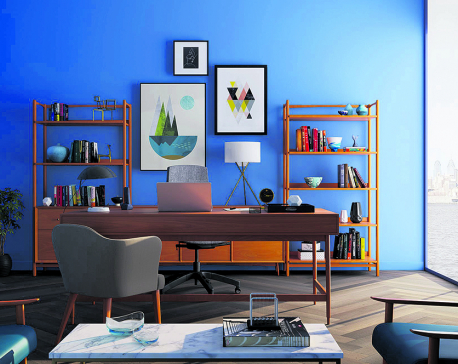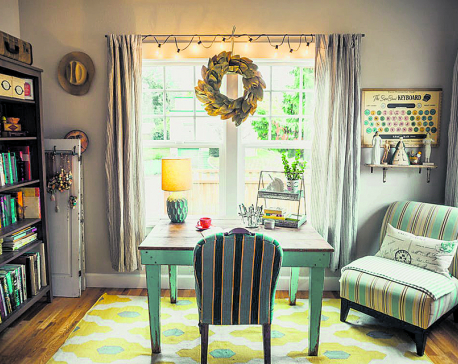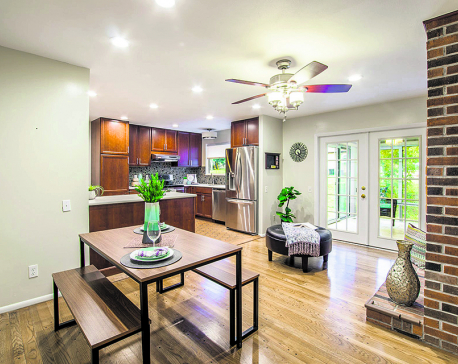
OR

Studies suggest messy people are smarter but then studies have also shown that women who live in cluttered spaces are likely to have high levels of the stress hormone cortisol. But for those of us with busy lifestyles, keeping our homes clean is a task that requires a lot of persistence and patience. There’s a way to go about it: Become a minimalist.
This “deliberate lack of decoration or adornment in style or design” started as an art movement back in the 1960s and has now paved its way into architecture as well as lifestyle. Architects have started to embrace minimalism in modern houses with the use of white walls and furniture, complemented by glass windows and limited use of accessories. If you too want to give minimalism a try, be it for its low maintenance or you are curious about the trend, here are a few ideas that can get you started.
Less is more
The whole idea of minimalism is based on the principle “Less is more”. If your living space has too much color, too many furniture, it makes you feel cramped and bogs you down. If you cleared out your entire living room for a day, you would be surprised how free and spacious it is, all hidden beneath the over the top furniture cabinets and stacks of cushion. The first step to embracing a minimalistic decor is to look around your living space. What things are must haves for you? If there is a decor piece that you rarely look at, then maybe it’s time to get rid of it.
Similarly, get rid of things that cramp up your living space – it could be a few extra cushions, a coffee table that is rarely touched or a shelf that you always bump into because it’s slightly in the way. Too many lamps also cramp up space with extra rods and wires, so get rid of them as well. Do this, every month look at the rooms in your house from a fresh perspective and identify things that you don’t think you need and get rid of them by selling or donating these items. As they say, one man’s trash is another man’s treasure.
De-clutter surfaces
If you go to someone else’s house and find papers, bills, coffee mugs, wires and other things spread out on the table or a shelf, it would certainly be off-putting, especially décor-wise. Surfaces like the kitchen counter and the dining table are also places that seem clustered with things that have appeared out of nowhere.
See if the things that have piled up can be thrown away or tucked somewhere it belongs. Cluttering causes a huge mess but is never helpful when you actually need to find something. For instance, you might need a scissor that, at this point, is hidden between two layers of phone chargers and a few back receipts and is nearly impossible for you to find.
Along with causing you stress, you will probably have to buy another scissor, which is a waste of time and resources. So, after de-cluttering, make an “everything has its place” system and learn to keep things back in their proper places when you are done using them. It might take some getting used to but, in the long run, you will be a lot more organized and you will find things around the house with relative ease.
Quality over quantity
The key to minimalism is to have few things as well as to have them in their original form, rather than something that is excessively modified. It’s the art of keeping it simple and real. The same applies to your living space as well. Whenever you are adding something to your room, be it art or a new flower vase, ask yourself if it is really needed? Does it add a new dimension to what you have going on already? If not, it’s better to scrap the idea. Similarly, minimalism and trends don’t go well together, so embracing minimalism will make you think twice before buying things and if you do buy something it will be thoughtful and meaningful. While choosing furniture and other items, choose ones that last longer and are worth your money.
Add texture rather than color
An “ideal” minimalist house embraces white and its shades as well as has very little color in it. A minimalistic room should have a neutral tone to it. However, all the lack of color might make a room seem a little bland or even boring. But just because you can’t go wild when it comes to colors doesn’t mean you can’t add some texture to your space. Give the room some sophistication with knitted throws, beaded pillows, sheepskin rugs, and velvet décor for that much-needed comfort factor. In case of white base, opt for similar beige, dove-gray, and tan tones or any color you would see together in nature. Add an indoor plant or two and there you have your much-needed dash of green – something that is soothing but not overpowering. And just like your room, your mind becomes clearer, leaving you space to get creative.
One in, one out
“One in, one out” is a process embraced by minimalists all over the world and it can definitely help one when it comes to keeping your home minimalistic. The philosophy goes something like this: For every item that comes into your home, something else should go out in return. The one-in item does not necessarily have to match the one-out item, although, to make a real difference, it should be something of a similar value or perhaps something even bigger. For instance, you can’t buy a big mantelpiece and throw out, say, a flower vase. You should make sure that they are similar items, at least in terms of shape, size, and purpose.

You May Like This

Décor ideas to spruce up your space
Most of us are guilty of decorating our homes when we first move in and then doing nothing to it... Read More...

Decor on a budget
You can often change the look and feel of a room dramatically just by rearranging the furniture. For instance, if... Read More...

Your guide to stylish, sustainable décor
Decorating your home in a sustainable, eco friendly approach is the need of the day. However, sustainable décor doesn’t mean... Read More...







Just In
- Karnali: Maoist Center’s Pariyar appointed as minister without portfolio
- Illam by-election: Nepal-India border to be 'sealed' from midnight today
- Gold price rises by Rs 500 per tola
- Emir of Qatar returns home after wrapping up state visit to Nepal
- Senate passes bill forcing TikTok’s parent company to sell or face ban, sends to Biden for signature
- PM Dahal hosts luncheon in honor of Qatari Emir
- Tata Sumo accident in Kavre leaves 10 injured, three in critical condition
- West Indies ‘A’ cricket team arrives in Nepal



_20240423174443.jpg)








Leave A Comment